|
RÍO MARAÑÓN: The Grand Canyon of the Amazon (Main) |
|
304 km (188 miles), class III-IV, 11-13 days [half-trip possible] |
| launches: May6 Sep14 Nov30 Dec20 (2025) RESERVE |
| OTHER TRIPS |
| versión ESPAÑOL |
The Amazon River (Río Marañon) in the Andes offers the finest raft-support trip in South America. Join our raft/kayak expedition as we paddle through the scenic and arid main Grand Canyon section, with fun class III-IV rapids, amazing side hikes, beautiful beach camps, friendly residents, and Incan ruins. Spread the word about the consequences of 12 planned dams and help us SAVE THE UPPER AMAZON! You also might have the option of starting on the UpperGC section and/or continuing into the Jungle Pongos.
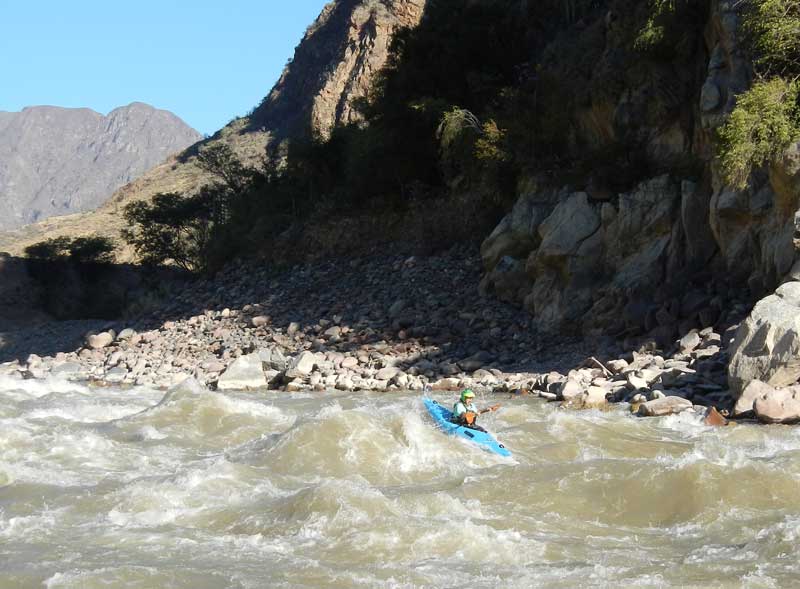
Río Marañon is the parent stream or "mainstem" source of the Amazon, meeting no stronger rival at any junction on its route to the Atlantic. It therefore is the Upper Amazon and the only stream meriting this title. From its birthplaces at glaciers on the highest tropical mountains in the world [Yerupajá and Huascarán; 6600-6800 m (21000-22000 ft)], the Marañon courses north over about 1/3 of the length of the country of Peru in the central Andes. As it does so, it is squeezed into the bottom of an arid canyon up to 3000 m (10000 ft) deep on both sides - more than double the depth of Arizona's Grand Canyon. A SierraRios expedition in 2012 explored what the Marañón was like, and learned of plans for over a dozen hydroelectric dams. The subsequent expeditions are intended to increase appreciation of the river by individuals so more authoritative opinions can be formed against the dams. Voice your opinion now in the SAVE RIO MARANON campaign. Sign a petition! Watch a film. Make the issue known. Support the cause with a donation! The trips are open to everyone: rafters, kayakers, IKers, and passengers. No prior whitewater experience is necessary on a raft.
Our main Grand Canyon Amazon trip is appropriate for anyone (even kids and families) and covers the following sections:
CentralGC:149 km; class II-III (IV); 6-7 days; Chagual-to-Balsas
LowerGC: 143 km; class III-IV; 6-7 days; Balsas-to-P.Malleta
- Some expeditions will continue 5 more days into the Jungle Pongos
- launches at low water (Jun-Oct) will be planned for 13-14 days total
- launches at high water Dec-Apr may be planned for only 11-12 days
- lt is possible to join or leave any expedition midway at Balsas
- Private groups are welcomed to schedule a trip - either as a fully guided trip or a self-organized experienced boater trip.
EMAIL LIST: Sign up for our email list (send an email) and you'll be be advised of upcoming trips and often special lower rates compared to the general contribution rate.
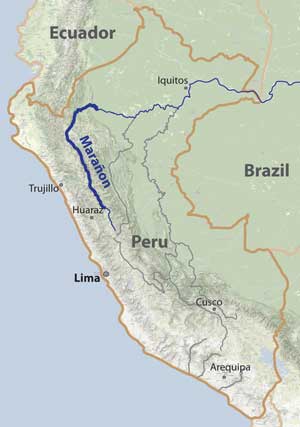
| MORE INFO: |
| 2017 article: Mens Journal |
| 2017 article: AW (Billings) |
| Film: ThePrimarySource(2015) |
| Film: Mission: Amazon (SUP) |
| 2012 trip (First Descent Amazon) |
| Former petition (ThePetitionSite) |
| Reports: Sep28:Jan16:Jun4 |
MARAÑON SECTIONS:
The "Grand Canyon Amazon" refers to the profound canyon section of Río Marañon located downsteam of the Río Puchka confluence and upstream of the Jungle Pongos section. This canyon is generally 2600-3000 m (8000-10000 ft) deep on both sides throughout its length. Access points conveniently divide it into four sections, each with various difficulties and other features. These are summarized in the table below. In general, the river is class III-IV in difficulty and comparable to the Grand Canyon of the Colorado (GCC), though some rapids in the UpperGC + InnerGorge sections are considerably more challenging.
Anyone (even folks with no river experience) can always join a normal SierraRios trip through any section scheduled and have experienced class V guides lead them safely on the trip. Ideally, participants in charge of a raft or kayak should feel challenged, but not scared. If you're planning to row or kayak, you should note the difficulties below.
Most SierraRios trips will be based in Truijllo and launch in Chagual to cover only the CentralGC+LowerGC sections. If there is enough interest, some trips may continue for 5-10 more days through the Bagua Valley and into the Jungle Pongos section. Some expeditions will start on the more difficult UpperGC+InnerGorge sections (but trips through the InnerGorge will occur only during lower water months of May-Oct).
| section | km | days | class | rapids | scenery | hikes | cultural | note | |
| Source | 20 | 3 | III-IV(P) | +++ | +++++ | ++ | +++ | incredible scenery in Cordillera Huayhuash | |
| Headwaters | 190 | ~10 | IV/P | +++++ | ++++ | ++ | + | not raftable; many long portages | |
| Upper GC | 127 | ~7 | IV | +++++ | +++++ | ++++ | ++ | one of the best week-long trips in Peru | |
| Inner Gorge GC | 81 | ~5 | IV (V) | +++++ | +++++ | +++ | + | very difficult; lining/portage at Wasson's | |
| Central GC | 149 | ~7 | II-III (IV) | +++ | +++++ | +++++ | +++ | incredible canyon scenery | |
| Lower GC | 143 | ~7 | III-IV | ++++ | +++ | +++ | +++++ | soon to be dammed: Veracruz & Chadin2 | |
| Cumba Valley | 81 | ~2 | I-II | + | ++ | + | ++ | flat and sometimes windy | |
| Jungle Pongos1 | 85 | ~3 | III+ | +++ | +++ | ++ | +++++ | lush jungle; often rainy; need Awajún permission | |
| Jungle Pongos2 | 215 | ~6 | I-II (III) | + | +++ | + | ++++ | mostly mellow big rio; need Awajún permission | |
| -------------------------- | -- | --- | --- | --- | --- | --- | --- | -------------------------- | |
| TOTAL RAFTABLE | 881 | 36 | - | - | - | - | - | awesome long Upper Amazon trip |
Upper Grand Canyon Amazon
For information on the UpperGC and InnerGorgeGC sections, see Grand Canyon Amazon (Upper) page.
====================================================================================
Central Grand Canyon Amazon
class II-III (IV)
149 km (93 miles); ~7 days
Chagual (1260m) to Balsas (860m) [4160 ft to 2830 ft]
2.7 m/km (15 ft/mile)
Google Maps (Chagual)
The Central Grand Canyon Amazon section is class II-III with one IV and features spectacular scenery, massive beach camps, friendly village visits, ruins, an incredible narrows, and some fun rapids. One of the best aspects of this section is the spectacular scenery of the arid desert-like cactus-filled canyon, as well as many vertical walls rising directly from the riverbed. An incredible spot along the river is the Muro Poso, a huge Zion-like wall with 400+ m waterfall coming almost directly down into the river. Other side excursions can be taken to pre-Incan tombs, into pueblos, up mountainsides, and into side canyons with incredible narrows, grottos, and waterfalls (one of the best is at Llanten). The section contains Calemar, a charming pueblo that was the setting of the famous novel La Serpiente de Oro and still has the preserved house of author Ciro Alegria. There are rapids as well, but after the first ~30 km with several class IIIs, the river courses through 80 km of class II where you can relax and soak in the incredible scenery for several days. The section ends with a bang of class III and IV rapids, the biggest of which is class IV Samosierra (aka Bombón), first described by the CanoAndes crew in 1980 and approximately a 9 or 10 on the GC scale. Samosierra starts class III-IV for almost a kilometer but then eases to intermittent class II for 7 km. Anyone comfortable rowing/paddling the Grand Canyon Colorado or MF-Main Salmon should be comfortable rowing/paddling the Central Grand Canyon Amazon. Two megadam projects (Rio Grande I and II) are planned for this stretch of the Upper Amazon, but the residents are mobilizing against them.
See slideshows of this section on various trips:
CENTRAL GC SLIDESHOW_Jan16 [from the Jan16 (2014) trip]
MCENTRAL GC SLIDESHOW_Sep28 [from the Sep28 (2013) trip]
====================================================================================
Lower Grand Canyon Amazon
class III-IV
144 km (89 miles); ~7 days
Balsas (860m) to Puerto Malleta (500m) [2830 ft to 1650 ft]
2.5 m/km (14 ft/mile)
Google Maps (Balsas)
The Lower Grand Canyon Amazon section is class III-IV with rapids interspersed throughout its length. It is equivalent in difficulty to the Grand Canyon of the Colorado, MF-Main Salmon, or Sun Kosi. The biggest rapids are El Choclón, Tupén Grande, San Lucas, Playa El Inca, Magdalena, and Linlín. Although some of these rapids are quite long, they are not more difficult than the toughest rapids on the Grand Canyon Colorado, even at high flows. The scenery of the Lower Grand Canyon Amazon is pleasant, starting out in a dry cactus-studded canyon and getting more and more annual precipiation with additional vegetation before becoming quite dry again in the Bagua Valley section. Side excursions include visits to abandoned pre-Incan overlooks and Incan tombs, to narrows, to the pueblos of Mendán or Tupén Grande, to a huge cavern, and to an intriguing series of swiming pools. It is important to have approval of the local communities in this section as they can be hostile to you if they don't know you (see C&K article; but read comments at end). This section has the dams in the latest planning stages: Chadin 2 and Veracruz. It will likely be the first to be drowned by reservoirs. The first take-out as the canyon opens up is Puerto Malleta, about a 1.5 hr drive from Jaén. From here, it is possible to paddle up to 80 km through the Cumba Valley section (class I-II) to Rentema, where the Jungle Pongos begin. Two dams (Chadin2 and Veracruz) are already approved to be built and will flood the entire Lower Grand Canyon section, but residents and SierraRios opposition have temporarily delayed the Chadin2 project (Veracruz is still moving forward as of 2016).
See slideshows of this section at low and high water:
LOWER GC SLIDESHOW_Jan16 [from the Jan16 (2014) trip]
LOWER GC SLIDESHOW_Sep28 [from the Sep28 (2013) trip]
====================================================================================
Jungle Pongos
The Marañon continues downstream of the Lower Grand Canyon Amazon section into the Cumba Valley and the the Jungle Pongos for an additional ~300 km before exiting the Andes into the flat Amazon basin. Some trips will continue 4 more days into the jungle. For more information on these sections, see Jungle Pongos.
====================================================================================
Prior descents:
Río Marañon has had only 3 near-complete descents
John Wasson et al., 1977: Paddled 790 km with 3 kayaks and a 12' raft from Rondos to Imacita (Nazareth) [Jul-Aug].
Tim Biggs et al., 2004: Kayaked all 1750 km in kayaks from Río Nupe to Iquitos: the entire river. [July 2004]
Contos et al., 2012: Boated all 1750 km river: "Headwaters" 200 km in kayaks (8 days), "Grand Canyon" 650 km with cataraft, 2 kayaks, and IK (28 days); "Lower Jungle" ~900 km to Iquitos in motorboats (7 days) [July 2012]
and many partial descents:
La Condamine 1743: rafted from Chiriaco confluence to Borja [then ship to the mouth of the Amazon]. [Jun-Sep, 1743]
Arturo Weatherman 1870: rafted from Utcubamba confluence down to past the Pongo de Manseriche.
Herbert Rittlinger, 1936: Attempted descent in Folbot kayak from near Rondos but aborted. Book sold 300,000 copies!
Laszlo Berty, 1976, 1977: Rafted ~450 km (maybe solo?) from Chagual to jungle (summer low water).
Andrzej Pietowski et al., 1981: Rafted 148 km from Chagual to Balsas only. [March 23-25, 1981]
Dignum et al.,1987: Group of 4 Dutch rafted 206 km section from near P.Copuma to Chagual. [Oct 1987]
Kurt Casey et al., 2000: Kayaked from Vizcarra confluence down to Chagual only. [July 9-18, 2000]
Dam survey parties, 2011-2013: [~8 trips on sections of the river between Chagual and Corral Quemado (2009 to 2012)]
SierraRios trip Sep28 2013: General group of 19-24; 30 days led by Contos: Puchka to Imacita.
SierraRios trip Jan16 2014: General group of 19-24; 29 days led by Contos: Puchka to Imacita.
SierraRios trip Jun4 2014: General group of 16-19; 29 days led by Contos: Puchka to Montenegro.
SierraRios trip Sep22 2014: Private group of 16 (Landes); led by Contos/Peña; 15 days Chagual to P.Malleta
SierraRios trip Oct1 2014: Private group of 18 (Gayner); led by Contos/Baca; 18 days Chagual to Montenegro
SierraRios trip Oct14 2014: General group of 12-14; 29 days led by Contos/Peña: Puchka to Montenegro
SierraRios trip Oct29 2014: General group of 10-14; 29 days led by Baca: Puchka to Montenegro
SierraRios trip Nov22 2014: Private group of 16 (McColluch) led by Peña/Bergamin; 15 days Chagual to P.Malleta
SierraRios trip Dec4 2014: General group of 11; led by Contos/Peña: 16 days Puchka to Imacita
SierraRios trip Jan7 2015: Private group of 15 (Drevo/Rae) led by Peña/Bergamin; 15 days Chagual to P.Malleta
PWP trip1 May16 2015: (Paddling With Purpose) group of ~12 led by Webb; 18 days Chagual to Montenegro
PWP trip2 Jun14 2015: (Paddling With Purpose) group of ~3 then 8 led by Webb; 10+8 days Source to Chagual
LA trip Jun24 2015: [non-SierraRios trip] Group of 12 organized by Anderson; 7 days Chagual to Balsas
SierraRios trip Jun28 2015: [2, 3] General group of 15; led by Contos/Peña; 14 days Puchka to Chagual
PWP trip3 Jul16 2015: (Paddling With Purpose) group of ~16 led by Webb; 16 days Chagual to P.Malleta
SierraRios trip Jul28 2015: Red Bull SUP + film crew; led by Contos (+Coto/Diaz/Peña); 52 days Source to Sarameriza
SierraRios trip Sep28 2015: General group of 10-12; led by Peña; 30 days Puchka to Nahém
SierraRios trip Oct6 2015: Private group of 4 (Plitschka); led by Diaz; 18 days Chagual to Imacita
SierraRios trip Oct13 2015: Private group of 16 (Moore); led by Coto; 24 days Puchka to P.Malleta
SierraRios trip Dec5 2015: General group of 12 ; led by Diaz (+Rondón/Peña); 18 days Chagual to Nahém
SierraRios trip Dec22 2015: Private group of 13 (Greiner); led by Peña/Benavuet; 14 days Chagual to Montenegro
SierraRios trip Jan14 2016: General group of 8 (Lisabeth); led by Peña/Diaz; 18 days Chagual to Montenegro
SierraRios trip Jul16 2016: General group of 10 (Saavedra); led by Peña/Diaz; 14 days Chagual to P.Malleta
SierraRios trip Sep29 2016: General group of 8 (Billings); led by Contos/Bergamin/Diaz; 26 days Puchka to P.Malleta
SierraRios trip Nov1 2016: Private group of 11 (Rudokas); led by Bergamin/Diaz/Gallese; 8 days Puchka to Huchus
Private trip Nov11 2016: Private group of 22 (Castillo); led by Castillo/Gallese; 13 days Chagual to P.Malleta
SierraRios trip Dec10 2016: General group of 8 (Naber); led by Peña/Diaz; 12 days Chagual to P.Malleta
SierraRios trip Dec22 2016: General group of 12 (Dickson); led by Peña/Diaz; 17 days Chagual to Imacita
SierraRios trip Dec30 2016: Private student group of 18 (Hawley); led by Peña; 7 days Puchka to P.Comaru
SierraRios trip Jan8 2017: General group of 12 (Lieberman); led by Peña/Diaz; 12 days Chagual to P.Malleta
SierraRios trip May28 2017: General group of 4 (Markel); led by Peña; 10 days Sanachgán to Chagual
SierraRios trip Jun14 2017: Private party (Kelty); led by Contos/Diaz; 44 days Source to Sarameriza
SierraRios trip Jul8 2017: General group of 8 (Bartholomew); led by Peña; 14 days Chagual to P.Malleta
SierraRios trip Nov2 2017: General group of 16 (Waggoner); led by Peña/Diaz; 14 days Chagual to P.Malleta
SierraRios trip Jun2 2018: Private group of 11 (Yanasak); led by Peña/Diaz; 12 days P.Copuma to Chagual
SierraRios trip Nov3 2018: Private group of 18 (Roehner); led by Peña/Diaz; 15 days Chagual to P.Malleta
SierraRios trip Dec4 2018: Private group of 6 (Rimmel); led by Peña/Diaz; 18 days Chagual to Imacita
SierraRios trip Jun26 2019: General group of 4 (Chandler); led by Peña/Diaz; 10 days P.Copuma to Chagual
SierraRios trip Jul6 2019: General group of 6 (Behle); led by Diaz/Peña/Gallese; 14 days Chagual to P.Malleta
SierraRios trip Jul9 2019: General group of 4 (Pangman); led by Peña/Lázaro; 7 days Chagual to Balsas
SierraRios trip Dec7 2019: Private group of 15 (Dartmouth); led by Peña/Diaz; 14 days Chagual to P.Malleta
SierraRios trip Dec24 2019: General group of 7 (Ferrer); led by Peña/Diaz; 13 days Chagual to P.Malleta
SierraRios trip Jun8 2022: Private group of 10 (Henke); led by Contos/Diaz; 13 days Chagual to P.Malleta
SierraRios trip Nov8 2022: General group of 12 (Nelson); led by Diaz; 18 days Chagual to Imacita
Note on SierraRios: with so many trips run to date, we at SierraRios have learned a lot about making the trips safe and enjoyable for everyone. For next year, we already have some groups scheduled and are offering several launch dates of general trips that anyone can join (see top of webpage). Our top-rate equipment and services ensure that our full-service trip have the quality of typical Grand Canyon outfitters such as AzRA, OARS, and Canyon Expedition, and also provide private experienced groups with the equipment, food packs, shuttle and services similar to what is provided by PRO, REO, Ceiba and Moenkopi (see Outfitting Service).
Personality/Experience:
No river rafting experience is required to join a trip. However, you should be comfortable camping and in good physical condition, and also should have an easygoing attitude in order to get along with a diverse group on a Grand Canyon-style trip for an extended period. If you are concerned about the latter issue, consider arranging a private trip, or if you're an experienced group, contracting our Outfitting Services. Note that in some sections of the river, it is essential to have bilingual guides who can communicate with the residents to ensure friendly interactions. Every participant must sign a liability waiver.
Everyone joining a trip should have an interest in river conservation and help us on our mission to document the river further, talk to residents, publicize the planned dams, and help train local guides. We welcome competent boaters. If you want to kayak, you must have adequate class IV experience and a solid roll. If you want to row a raft, you must have adequate experience rowing class IV rivers. Comparable rivers are the Colorado (Grand Canyon), Middle Fork Salmon (high water), Thompson, Futaleufu, Karnali, or Sun Kosi. In general, the pace is relaxed with layover days planned, but there may be some long days on the water.
The policy we will take on the trip is that the trip leader will have main authority when it comes to decisions for the group regarding river progress, camp, etc. If a participant has overestimated their ability to row or kayak, he/she may be mandated to ride on a raft and/or be assessed other penalties. Trip leader decisions can be vetoed by a majority vote of the group. Any participant always has the right to leave the trip if they so desire, but no refund is due.
Leadership/Decisions:
The policy we will take on the trip is that the trip leader will have main authority when it comes to decisions for the group regarding river progress, camp, etc. If a participant has overestimated their ability to row or kayak, he/she may be mandated to ride on a raft and/or be assessed other penalties. Trip leader decisions can be vetoed by a majority vote of the group. Any participant always has the right to leave the trip if they so desire, but no refund may be due.
RENDEZVOUS POINTS/TRANSPORTATION
TRUJILLO: See TRUJILLO RENDEZVOUS for general information regarding Trujillo, including getting there and accommodations. Our group will rendezvous in Truijllo with a meeting the night before departure day. On departure day, we will leave by 7 am in a van or bus for the long ride (12 hr) to Chagual. The next morning we will finish rigging and launch. It is possible to arrive to Chagual by flight ($140; 1 hr; Atasur; departures 7am Tue, Thur, Sat).
BALSAS / CAJAMARCA: Balsas is a pueblo by the river dividing the Central Grand Canyon Amazon section from the Lower Grand Canyon Amazon section. It is possible to enter or exit a trip here. From the river access bridge at Balsas it is a 1.7 hr drive up to Celendín (taxi), and then a 3 hr ride to Cajamarca (bus or taxi). Regular flights and buses serve Cajamarca to/from Lima. Two domestic carriers service Cajamarca-Lima (LATAM and LC Peru) for $120-180 one-way. You can also take a 14 hr bus to Lima ($30) - some are quite comfortable with reclining "cama" seats.
PUERTO MALLETA / JAEN: See TRIP END for information about the end point of Puerto Malleta and the final city of Jaén where SierraRios service ends. Although the standard trip ends at Puerto Malleta, some trips may continue into the Jungle Pongos section. Briefly, Puerto Malleta is a 1.5 hr drive from Jaén. From Jaén it is a 7 hr bus ride to Chiclayo, where there is regular bus service (12 hr) to Lima. You can also take a commercial flight to Lima on LATAM(1 hr). Alternatively, from Jaén or Bagua you can go to Tarapoto (~8 hr ride to the east) in the Amazon jungle and catch a flight from there to Lima. For flights, check STAR, LATAM, PeruvianAir, or LC Peru.
TENTATIVE ITINERARY:
Itineraries and camps may vary from trip to trip. This is a sample itinerary that has worked well in the past for the Central+LowerGC Grand Canyon Amazon trip (see Upper+InnerGorge if doing the upper section), though some shorter trips may start a little downstream at Calemar (1-2 days shorter):
Day 0: rendezvous in Trujillo; meet trip leader in afternoon
Day 1: Arrival to Chagual; rigging; safety and camp talk; possible Pumurgo (III-IV) run; camp
Day 2: Central GC; pass Vijus; Hualango (III), Gansul (III); Llaupuy side hike; ~30 km
Day 3: Central GC; possible hike; lunch at Calemar; Río Choclo clear stream; class II; ~20 km
Day 4: Central GC; easy river day with beautiful scenery; camp near giant wall & falls of Muro Poso; class II; ~20 km
Day 5: Central GC; Muro Poso; hike Cangrejo and/or Sute ruins; Montevideo tombs; (camp by Llanten); ~28 km
Day 6: Central GC; layover; hike to Llanten Narrows/Falls; Jecumbuyl; 20 km
Day 7: Central GC; Big rapids day: Llanten (III-IV) & Samosierra (IV); camp near Trapiche or Chacanto; class IV; ~30 km
Day 8: Lower GC; lunch at Balsas/Chacanto; possible cooler exchange/food resupply; class III; ~40 km
Day 9: Lower GC; Playa El Cura citadel hike; El Choclón (III-IV); Santa Rosa (III); to Mendán or Tupén Grande; III-IV; ~30 km
Day 10: Lower GC; meet villagers; visit chacras; possible Pachamanca; class III; ~30 km
Day 11: Lower GC; San Lucas; Chadin II dam site; Playa El Inca; camp at/near Magdalena; class III-IV; ~30 km
Day 12: Lower GC; Magdalena; Linlín; Totora; Sauce; pools at Q.Agua Blanca; class III-IV; ~30 km
Day 13: Lower GC; Palaguas; Amazon Cavern; arrive Puerto Malleta by 1 pm; derig; ride to Bagua; hotel; class III; 20 km
From here down you might continue into the Jungle Pongos trip (~5 extra days usually)
Sites/Excursions:
Aside from excursions during the river trip, you might consider visiting other interesting places in northern Peru, including the Incan/colonial city of Cajamarca, various thermal baths nearby, natural wonders such as the Catarata de Gocta (771 m high and one of the tallest waterfalls in the world), as well as many ruins such as Caral, the oldest known city in the Americas (near Barrancas on the coast), Kuelap, the Machu Picchu equivalent of the Chacahpoyas culture (near Chachapoyas). Note that Cajamarca was a major Incan city and the site where Pizarro met and defeated Atahualpa, who had recently assumed title of full emperor of the Inca after defeating his brother Huáscar.
Maps:
SierraRios has all topo maps of the entire river marked with rapids and potential beach camps. If you would like access to these, you can sign up as a member of SierraRios specifying you're interested in the Marañon map/book/video, and you'll receive immediate access to the maps (book/DVD later). If you have the password, click here for access: MAPS. [also note links at top left column of this page and at TOPO MAPS on the main www.SierraRios.org homepage.
CLIMATE AND BUGS:
The trip occurs at tropical latitudes in semi-arid country and at moderate elevation. Average annual precipitation is about 450 mm (19 in) near Puchka and 330 mm (13 in) at Balsas. The elevation at the put-in is 6900 ft, so expect warm days and cool evenings in the initial sections (highs of 27oC/80oF and lows of 10oC/50oF are common the first days). Water is pretty cool (15-20oC) initially. After the first week of the trip, it will generally be hot (highs of 32oC/90oF and lows of 20oC/68oF generally) and the water warms up considerably (to ~23oC by the jungle).
There is almost no rain in the dry season May-Sep in the Upper Grand Canyon Amazon section, but expect some in the rainy season. On our July 2012 and June 2014 trips, we had only a few sprinkles of rain for the first 25 days. Once we entered the Jungle Pongos, we experienced rain every day or two, usually in short intense storms.
Expect daytime-biting midges (no-see-ums) in most camps, especially during the dry season when they are worst. Use DEET and/or lemon eucalyptus repellents to prevent bites, and bring light clothing to cover you legs and ankles. Mosquitos are not present at most camps but can come out at night in a few areas. They are much more common in the jungle. Other critters to beware of are spiders, scorpions, snakes, and giant centipedes.
COST
This trip is being run to increase appreciation of the river and help preserve this unique natural resource. We welcome everyone: raft passengers, raft paddlers, raft rowers, kayakers, IKers, and guides. The pricing policy has been carefully considered and takes into account the costs associated with running the trip, the services offered, and what other outfitters charge for similar long multi-day raft trips. See the current rates and what's includedr at: TRIP COSTS
Special discounts are sometimes offered to folks on our email list, so you are encouraged to sign up (Email List info).
RESERVATIONS
If interested in joining a trip, start a discussion by sending a note stating how you found out about the trip and a little background info about you and your paddling experience, what dates might work for you, and what sections of the expedition you are most interested in joining. Once you get the go-ahead, you will need to provide a deposit to reserve your place on the trip. The balance must be received prior to trip commencement. See PAYMENTS for payment options.
A minimum of 6 full-rate guests will assure a general SierraRios trip occurs, while our maximal limit is 16 guests on any trip. We may allow trips with fewer folks depending on circumstances. The current boats available allow for two trips at a time. If interested in doing a trip on a date not listed, send a message about optimal scheduling for you, as well as a little info about you. We may list the launch date, and if enough folks sign up by the 3-month cut-off, we'll organize it.
TRIP LEADERS AND TEAM MEMBERS:
(guides may include the following)
(1) Rocky Contos is often the trip leader. He descended the entire Marañon from its headwaters on Río Lauricocha to Iquitos from July to September 2012, and eight additional 20+ day expeditions in 2013 (Sep28), 2014 (Jan16, Jun4, Oct14, and Dec4), 2015 and 2016. He discovered the most distant source of the Amazon [see articles C&K, Outside, Nat.Geo, FoxNews, LaRepublica] and also paddled all of Ríos Apurímac, Mantaro, and Urubamba as part of his Headwaters of the Amazon expedition. Rocky is fluent in Spanish, trained in Swiftwater Rescue Pro, and as a Wilderness First Responder. For more info on Rocky, see Bio_Rocky.
(2) Pedro Peña will be trip leader on many expeditions. Pedro was born in Lunahuana near Lima and started kayaking and rafting at a young age on the Lunahuana. He has been a raft guide for most of this life on the Cañete, Apurímac, and Futaleufu. Bilingual and a class V kayaker and rafter, Pedro has guided our trips >15X and is very familiar with the river and residents in the entire Grand Canyon section.
(3) Ariel Diaz will be trip leader on many expeditions. Ariel is a Peruvian resident and river guide but was born in Uruguay. He has guided in Argentina, Chile (Futaleufu), Bolivia (SanPedro-Grande and Pilcomayo), Peru (Marañón, Cañete, Apurímac), Italy and Mexico. As of 2018 he has guided the Marañón >12X and is very familiar with all rapids and the residents along the way.
(4) Other river guides may be employed at times, including Fico Gallese, a Peruvian guide from Cusco who has a ton of experience guiding the Apurimac, Tambopata, Urubamba and Futaleufu, Julio Baca, a class V kayaker and rafter from near Cusco who has guided in many areas of the world, Alonso Campana ("Rambo") a class V rafter and kayaker who helped guide the Upper+Central GC Amazon trip, and/or Andrey Coto, a Costa Rican guide who has worked in CR, Switzerland, Chile, Ecuador, and Mexico (and has guided 3 Marañón trips).
(6) Eusebio Chumpi, Zacarias Cumbia, or other Awajún will be local guides with the group in the jungle Aguaruna areas. It is not possible to pass without approval from the Aguaruna nation [you will be detained and possibly robbed/attacked] and such local guides. Eusebio or his son Manasés Chumpi joined the 2012, 2013 and 2014 trips and will likely join future trips. In addition, sometimes we will have other Awajún with us, such as Segundo Valera, and local conservationist Luciano Troyes of Gotas de Agua.
SAFETY / HEALTH
(click here)
WATER LEVELS
See more info at Marañón Water Levels. The river is generally about the same volume as the Colorado through Grand Canyon.
| river | Ene | Feb | Mar | Abr | May | Jun | Jul | Ago | Sep | Oct | Nov | Dic | Avg | |
| Marañon (at Balsas) | cms | 640 | 920 | 980 | 870 | 410 | 210 | 140 | 130 | 140 | 240 | 450 | 580 | 475 |
| cfs | 22800 | 32700 | 34700 | 30600 | 14700 | 7500 | 5000 | 4600 | 5000 | 8400 | 16200 | 21400 | 17000 | |
| ---------------------------- | ----- | -------- | -------- | -------- | -------- | -------- | -------- | -------- | -------- | -------- | -------- | -------- | -------- | -------- |
| Colorado (LeesFerry) | cms | 148 | 188 | 259 | 560 | 1188 | 1476 | 597 | 293 | 234 | 234 | 175 | 163 | 486 |
| [pre-dam flows 1922-1962] | cfs | 5300 | 6700 | 9200 | 19900 | 42200 | 52400 | 21200 | 10400 | 8300 | 8300 | 7500 | 5800 | 16480 |
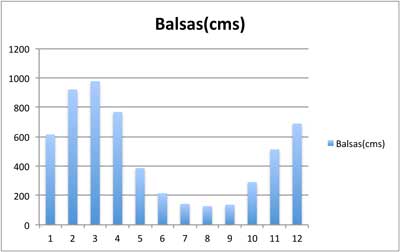
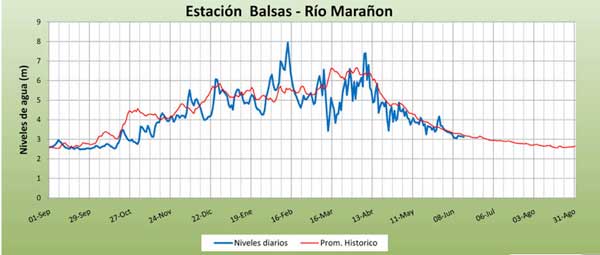
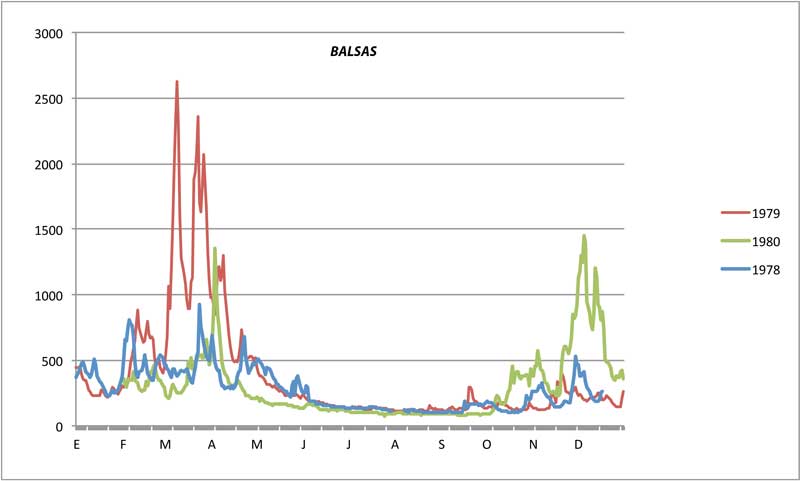
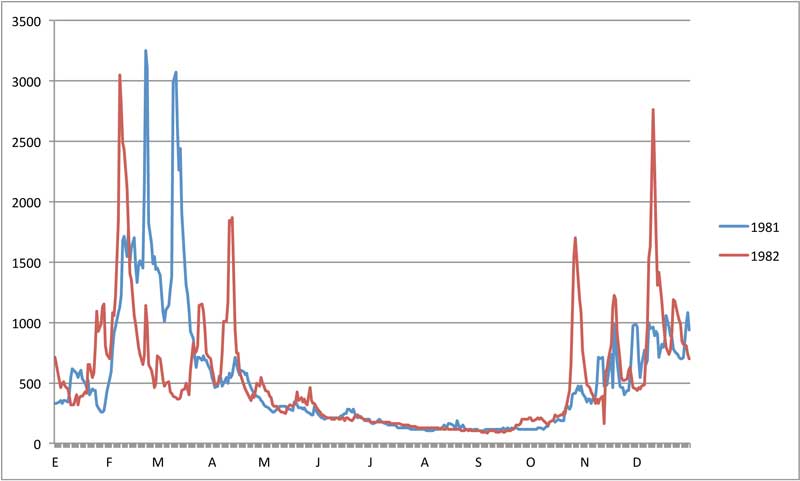
BOATS AVAILABLE IN PERU:
[current list available]
A FEW COMMENTS FROM PAST PARTICIPANTS:
"The Marañón resembles the Grand Canyon of Colorado in many ways with its rapids, beaches, side canyons and deep cacti-studded gorges. Both rivers offer numerous side-hikes and waterfalls. Like the Canyon, the Maranon is ideal for a long multi-day boat trip where a person can forget the grind of everyday life... However, the Maranon offers much more. Unlike the Grand Canyon, the Maranon is free flowing and its character can change overnight by the whims of nature. Its navigable section is much longer than that of Colorado and its canyon is deeper. Some Maranon beaches are big enough to accommodate small villages. The Maranon offers more and greater variety of rapids that are overall more challenging to navigate. Its continuously strong current makes it possible to easily cover 30-40 miles per day in a raft, assuming one does not stop for side hikes. The jungle area of the lower Maranon has no equivalent on the Colorado... I cannot think of another river in the lower 48 States that offers the same kind of experience."
Boris Trgovcich, class IV rafter/IKer and former raft tour operator in N.California. [2013Sep Marañon trip participant]
See Full Comment
"I found the river trip labeled the "Grand Canyon of the Amazon" to be completely comparable to the Grand Canyon of the Colorado in most respects, and it exceeded my expectations in every way... In the 1980s I paddled the Bio-Bio as a participant on one of the first commercial kayak trips in Chile [with] Chris Spelius. While [the Bio Bio's] destruction was abominable both environmentally and culturally, the size and importance of the Bio-Bio's destruction was but a small warning shot compared to the potential disaster planned for the Marañón/Amazon."
Kelly Kellstadt, class III-IV kayaker and former guide/instructor in New Mexico. [2013Sep Marañon trip participant]
See Full Comment
"I need to do another expedition!!!!! I'm already jonsing for one .... The Marañon trip was one of kind that I will never forget ... the perfect combination of big water, gorgeous scenery and a taste of rurual Peruvian lifestyle! ... I would do this trip again in a heart beat ... It really is amazing how helpful some people have been along the way. Going way out of their way in order to help..."
Amie Begg; class IV kayaker on 2012 Marañon trip
"The Marañon trip was a magical journey. Big, clean water; big canyons and expansive natural beauty; and big-hearted, friendly people who made us feel welcome along the way, while sharing with us their fears of imminent dams, mines, and petroleum drilling. I hope we can find a way to help them protect this incredible treasure and their ways of life."
Barbara Conboy; SierraRios board member and rafter/kayaker on 2012 Marañon trip